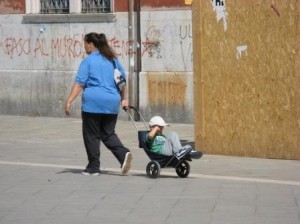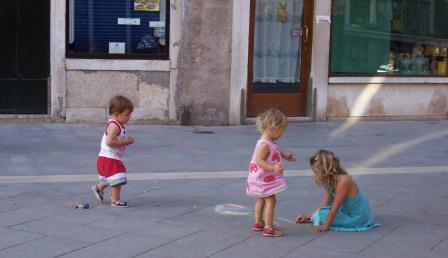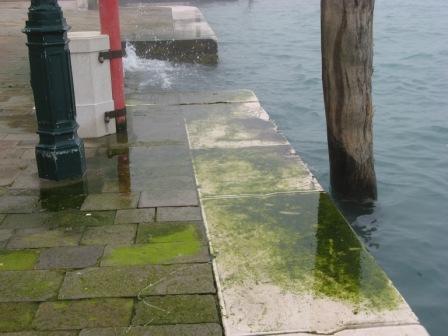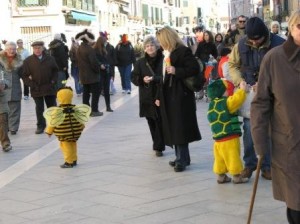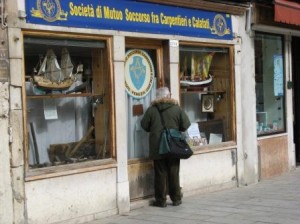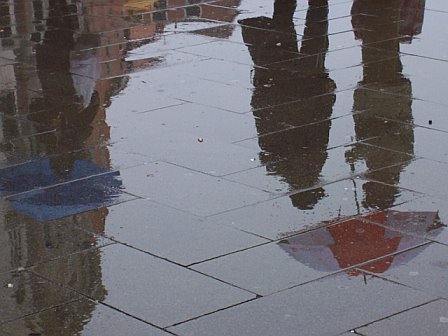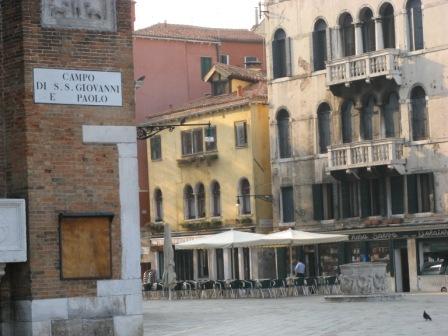
One Sunday afternoon as I was toiling along toward the Fondamente Nove on my way to Burano, I stopped for refreshment (coffee and use of the bathroom) at the elegant cafe/bar Rosa Salva in Campo Santi Giovanni e Paolo.
Let me note right here that although travel writers seem to love propagating “Zanipolo,” the ancient Venetian name for this trusty duet of saints, I myself have never heard any Venetian use that word, even by mistake. That era, whenever it was, is long, long gone. (I have seen it written, occasionally, on local boats or bars.) I just wanted to point that out.
Anyway, it was a miserable day. When it rains like that the entire world goes sodden, nothing escapes. Your skin isn’t just wet, it’s saturated. The air, your clothes, your brain. A day like this makes you want to just stay in bed, with the (sodden) covers pulled over your (sodden) head.
Not surprisingly, there were no other customers in the cafe. A dark-haired girl and a young man wearing glasses were standing behind the bar. I smiled and gave that whaddya-gonna-do shrug toward the weather and the world.
I said, “Why are we here?”
They smiled. He said, “Good question. There’s nobody around — nobody. And there’s five of us here to work today. Some days even with five we’re working like crazy, but look at this. There’s nothing to do.”
Helpful little Anglo-Saxon, no-minute-left-unexploited me, bounces right in: “You could read a book,” I offered. “Write some letters. Do needlepoint. Write the story of your life. Not the stuff that happened, but the stuff you wish had happened. Your dreams.”
Did someone say dreams? He was ready. “My dream was to become a captain of a vaporetto with the ACTV [the local transport company],” he replied.
“Good grief!” I said (or rather, its Venetian equivalent). “If you’re going to dream, dream big! Captain of a vaporetto? Why not make it captain of a cruise ship? After all, it’s just dreams. Go for it!”
“Well, no,” he replied, unruffled. “It would be enough for me. It’s a secure position, you work your seven hours and then you go home.” (This the classic philosophy of a certain sort of person here: I need to work but don’t let it disturb my life.) “Besides, my father was captain of a cruise ship and he was gone for weeks at a time.” Oops. I was aiming at the wrong dream.
“Well, that changes things,” I said. “You know what you’re talking about. So fine. Why don’t you apply to the ACTV?”
“I did.” He gestured toward his glasses. “You can’t make it if you wear glasses.”
I didn’t want to give in. “So have the operation!”
“I could do that” — he had obviously been serious about this dream, small as it might have seemed to me. “It would correct the near-sightedness, but not the astigmatism.” (Or the other way around, I can’t remember.)
“I wouldn’t have minded being a train driver,” he went on, “but it’s the same problem about the eyes. ”
“Subway driver?” (Somewhere else, obviously, not here.) Nope — anyone who wants to work at something that’s part of the autotramvieri union, it’s the same story. He was stuck.
He had sort of made his peace with it, but he was still young enough to feel the empty space where what he wanted to be his life was supposed to have been put. Meanwhile he’s making do with carrying overpriced cappuccinos to exhausted tourists. Or not, as is the case today.
“Well,” I said, still trying to be helpful but drastically changing tack, “just think, anyway you’ve still got your eyes. How many people could say they wish they had your problems?” Not the best contribution, being repulsively banal, but true, which is something, anyway.
He agreed. Well, what else could he do? Evidently he had long since reached that conclusion, the idea that things could have been, or be, worse. But meanwhile the rain is pouring down, and the motor has pretty much stalled in his life, so to speak. Whether he simply needs more fuel, or new spark plugs, or some part that’s more expensive and hard to find (“…we’ll have to order it…”…”it will be two months…” …”everybody’s closed for Christmas/New Year’s/summer vacation”…) I hope he finds it and gets his life moving again. He’s too young to stay stalled in the breakdown lane of life like this.

